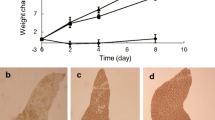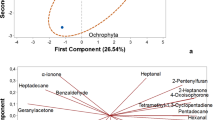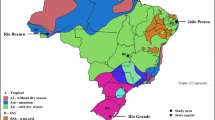Abstract
Volatile organic compounds in marine algae have been reported to comprise characteristic flavor of algae and play an important role in their growth, development and defensive response. Yet their biogeneration remain largely unknown. Here we studied the composition of volatile compouds in Pyropia yezoensis and their variations in response to methyl jasmonate (MeJA) and diethyldithiocarbamic acid (DIECA) treatment using gas chromatography-mass spectrometry (GC-MS). A total of 44 compounds belonging to the following chemical classes (n) were identified, including aldehydes (11), alcohols (8), acids and esters (6), alkanes (5), ketones (5), alkenes (3), and S- or N-containing miscellaneous compounds (6). External treatment with plant hormone MeJA increased the content of 1-dodecanol, 4-heptenal, and 2-propenoic acid-2-methyl dodecylester, but decreased the content of phytol, 3-heptadecene, 2-pentadecanone, and isophytol. When pretreated with DIECA, an inhibitor of the octadecanoid pathway leading to the biosynthesis of endogeneous jasmonates and some secondary metabolites, phytol and isophytol were increased, while 4-heptenal, 1-dodecanol, and 2-propenoic acid-2-methyl dodecylester were decreased, both of which were negatively correlated with their variations under MeJA treatment. Collectively, these results suggest that MeJA does affect the volatile composition of P. yezoensis, and the octadecanoid pathway together with endogenous jasmonate pathway may be involved in the biosynthesis of volatile compounds, thereby providing some preliminary envision on the composition and biogeneration of volatile compounds in P. yezoensis.
Similar content being viewed by others
References
Akakabe, Y., and Kajiwara, T., 2008. Bioactive volatile compounds from marine algae: Feeding attractants. Journal of Applied Phycology, 20 (5): 661–664.
Arnold, T. M., Targett, N. M., Tanner, C. E., Hatch, W. I., and Ferrari, K. E., 2001. Evidence for methyl jasmonate induced phlorotannin production in Fucus vesiculosus (Phaeophyceae). Journal of Phycology, 37 (6): 1026–1029.
Boonprab, K., Matsui, K., Akakabe, Y., Yoshida, M., Yotsukura, N., Chirapart, A., and Kajiwara, T., 2006. Formation of aldehyde flavor (n-hexanal, 3Z-nonenal and 2E-nonenal) in the brown alga, Laminaria angustata. Journal of Applied Phycology, 18 (3-5): 409–412.
Bouarab, K., Adas, F., Gaquerel, E., Kloareg, B., Salaün, J. P., and Potin, P., 2004. The innate immunity of a marine red alga involves oxylipins from both the eicosanoid and octadecanoid pathways. Plant Physiology, 135 (3): 1838–1848.
Cock, J. M., Sterck, L., Rouzé, P., Scornet, D., and Allen, A. E., 2010. The Ectocarpus genome and the independent evolution of multicellularity in brown algae. Nature, 465: 617–621.
Collén, J., Hervé, C., Guisle-Marsollier, I., Leger, J., and Boyen, C., 2006. Expression profiling of Chondrus crispus (Rhodophyceae) after exposure to methyl jasmonate. Journal of Experimental Botany, 57 (14): 3869–3881.
Dar, T. A., Uddin, M., Khan, M. M. A., Hakeem, K. R., and Jaleel, H., 2015. Jasmonates counter plant stress: A review. Environmental and Experimental Botany, 115: 49–57.
Farmer, E. E., Caldelari, D., Pearce, C., Walker-Simmons, M. K., and Ryan, C. A., 1994. Diethyldithiocarbamic acid inhibits the octadecanoid signaling pathway for the wound induction of proteinase inhibitors in tomato leaves. Plant Physiology, 106 (1): 337–342.
Ferraces-Casais, P., Lage-Yusty, M. A., Rodríguez-Bernaldo de Quirós, A., and López-Hernández, J., 2013. Rapid identification of volatile compounds in fresh seaweed. Talanta, 115: 798–800.
Flament, I., and Ohloff, G., 1984. Volatile constituents of algae: Odoriferous constituents of seaweeds and structure of nor-terpenoids identified in Asakusanori flavor. In: Progress in Flavor Research, Adda, J., ed., Elsevier, Amsterdam, 281–300.
Fujii, S., Yamamoto, R., Miyamoto, K., and Ueda, J., 1997. Occurrence of jasmonic acid in Dunalliela (Dunalielales, Chlorophyta). Phycological Research, 45 (4): 223–226.
Fujimura, T., Kawai, T., Kajiwara, T., and Ishida, Y., 1994. Volatile components in protoplasts isolated from the marine brown alga Dictyopteris prolifera (Dictyotales). Plant Tissue Culture Letters, 11 (1): 34–39.
Gupta, S., and Abu-Ghannam, N., 2011. Bioactive potential and possible health effects of edible brown seaweeds. Trends in Food Science & Technology, 22 (6): 315–326.
Hamberg, M., and Gerwick, W. H., 1993. Biosynthesis of vicinal dihydroxy fatty acids in the red alga Gracilariopsis lemaneiformis: Identification of a sodium-dependent 12-lipoxygenase and a hydroperoxide isomerase. Archives of Biochemistry and Biophysics, 305 (1): 115–122.
Hamberg, M., Gerwick, W. H., and Asen, P., 1992. Linoleic acid metabolism in the red alga Lithothamnion corallioides: Biosynthesis of 11(R)-hydroxy-9(Z),12(Z)-octadecadienoic acid. Lipids, 27 (7): 487–493.
Hu, C. M., Xu, J. L., Zhu, J. Y., Yan, X. J., Luo, Q. J., Yang, J. X., and Xu, P., 2011. Characteristic volatile matters in Porphyra (Bangiales). Marine Sciences, 35 (5): 106–111.
Jürgens, A., Witt, T., and Gottsberger, G., 2003. Flower scent composition in Dianthus and Saponaria species (Caryophyllaceae) and its relevance for pollination biology and taxonomy. Biochemical Systematics and Ecology, 31 (4): 345–357.
Kajiwara, T., Kashibe, M., Matsui, K., and Hatanaka, A., 1990. Volatile compounds and long-chain aldehydes formation in conchocelis-filaments of a red alga, Porphyra tenera. Phytochemistry, 29 (7): 2193–2195.
Kajiwara, T., Matsui, K., Akakabe, Y., Murakawa, T., and Arai, C., 2006. Antimicrobial browning-inhibitory effect of flavor compounds in seaweeds. Journal of Applied Phycology, 18 (3-5): 413–422.
Kajiwara, T., Matsui, K., and Akakabe, Y., 1996. Biogeneration of volatile compounds via oxylipins in edible seaweeds. In: Biotechnology for Improved Foods and Flavors. Takeoka, G. R., et al., eds., American Chemical Society, Washington DC, 146–166.
Kajiwara, T., Matsui, K., Hatanaka, A., Tomoi, T., Fujimura, T., and Kawai, T., 1993. Distribution of an enzyme system producing seaweed flavor: Conversion of fatty acids to longchain aldehydes in seaweeds. Journal of Applied Phycology, 5 (2): 225–230.
Kladi, M., Vagias, C., and Roussis, V., 2004. Volatile halogenated metabolites from marine red algae. Phytochemistry Reviews, 3 (3): 337–366.
Kodama, K., Kajiwara, T., Matsui, K., and Matsui, K., 1993. Volatile compounds from Japanese marine brown algae. In: Bioactive Volatile Compounds From Plants. Teranishi, R., et al., eds., Washington DC, American Chemistry Society, 103–120.
Krupina, M. V., and Dathe, W., 1991. Occurrence of jasmonic acid in the red alga Gelidium latifolium. Zeitschrift für Naturforschung C, 46: 1127–1129.
Kumari, P., Reddy, C. R., and Jha, B., 2015. Methyl jasmonateinduced lipidomic and biochemical alterations in the intertidal macroalga Gracilaria dura (Gracilariaceae, Rhodophyta). Plant Cell Physiology, 56 (10): 1877–1889.
Küpper, F. C., Gaquerel, E., Cosse, A., Adas, F., Peters, A. F., Müller, D. G., Kloareg, B., Salaün, J. P., and Potin, P., 2009. Free fatty acids and methyl jasmonate trigger defense reactions in Laminaria digitata. Plant Cell Physiology, 50 (4): 789–800.
Menke, F. L. H., Parchmann, S., Mueller, M. J., Kijne, J. W., and Memelink, J., 1999. Involvement of the octadecanoid pathway and protein phosphorylation in fungal elicitor-induced expression of terpenoid indole alkaloid biosynthetic genes in Catharanthus roseus. Plant Physiology, 119 (4): 1289–1296.
Neelamathi, E., and Kannan, R., 2016. Screening and characterization of bioactive compounds of Turbinaria ornata from the gulf of Mannar, India. American-Eurasian Journal of Agricultural & Environmental Sciences, 16 (2): 243–251.
Nor Qhairul Izzreen, M. N., and Vijaya Ratnam, R., 2011. Volatile compound extraction using solid phase micro extraction coupled with gas chromatography mass spectrometry (SPMEGCMS) in local seaweeds of Kappaphycus alvarezii, Caulerpa lentillifera and Sargassum polycystem. International Food Research Journal, 18 (4): 1449–1456.
Wasternack, C., and Hause, B., 2013. Jasmonates: Biosynthesis, perception, signal transduction and action in plant stress response, growth and development. An update to the 2007 review in Annals of Botany. Annals of Botany, 111: 1021–1058.
Whelan, J., Tarafa, M. E., and Hunt, J. M., 1982. Volatile C1-C8 organic compounds in macroalgae. Nature, 299 (5878): 50–52.
Yamamoto, M., Baldermann, S., Yoshikawa, K., Fujita, A., Mase, N., and Watanabe, N., 2014. Determination of volatile compounds in four commercial samples of Japanese green algae using solid phase microextraction gas chromatography mass spectrometry. The Scientific World Journal, 289780, DOI: 10.1155/2014/289780.
Zeneli, G., Krokene, P., Christiansen, E., Krekling, T., and Gershenzon, J., 2006. Methyl jasmonate treatment of mature Norway spruce (Picea abies) trees increases the accumulation of terpenoid resin components and protects against infection by Ceratocystis polonica, a bark beetle-associated fungus. Tree Physiology, 26 (8): 977–988.
Zhao, J., Davis, L. C., and Verpoorte, R., 2005. Elicitor signal transduction leading to production of plant secondary metabolites. Biotechnology Advances, 23 (4): 283–333.
Acknowledgements
This work was supported by a grant from the PhD fellowship program of Soochow University and the National Natural Science Foundation of China (No. 41276134).
Author information
Authors and Affiliations
Corresponding author
Rights and permissions
About this article
Cite this article
He, L., Wang, L., Wang, L. et al. Effects of Methyl Jasmonate on the Composition of Volatile Compounds in Pyropia yezoensis. J. Ocean Univ. China 17, 291–296 (2018). https://doi.org/10.1007/s11802-018-3319-y
Received:
Revised:
Accepted:
Published:
Issue Date:
DOI: https://doi.org/10.1007/s11802-018-3319-y




